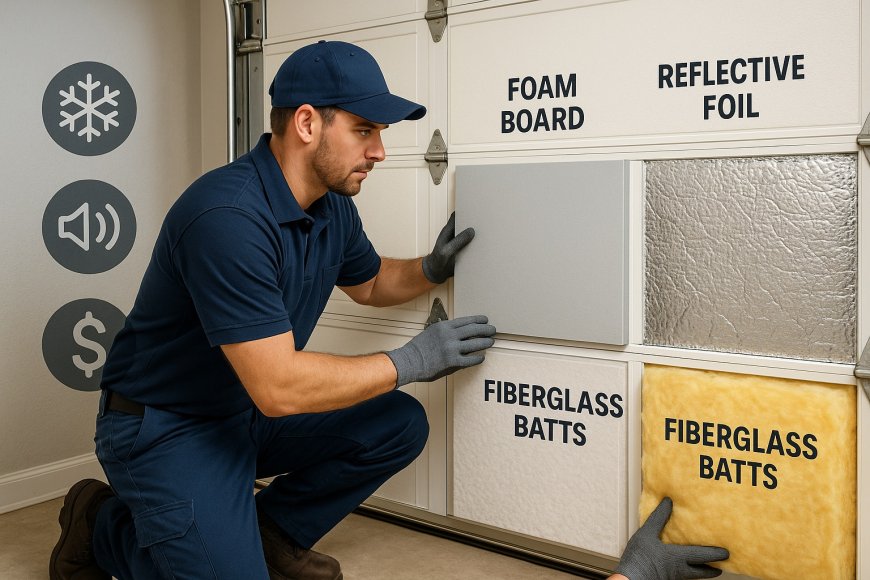Which insulation works best for garage door replacement?
Find out which insulation type is best for garage door replacement to boost energy efficiency, reduce noise, and enhance comfort.

Starting a garage door replacement project can spark a lot of questions, especially when it comes to choosing the right insulation. You might wonder if insulation really makes a difference, or which type is best suited for your space. The truth is, the insulation you pick can completely change how comfortable, quiet, and energy-efficient your garage feels year-round. Whether you use your garage as a workspace, a gym, or simply for parking, understanding your options will help you make a choice you wont regret. Lets explore the world of insulation so you get the most out of your garage door replacement.
Why Insulating Your Garage Door Matters
Imagine standing in your garage on a freezing morning or a blazing hot afternoon. Without proper insulation, your garage door acts like a giant metal bridge between the outdoors and your home, letting in unwanted temperatures and even noise. Insulation creates a barrier that helps keep your garage warmer in winter, cooler in summer, and much quieter overall. Plus, if your garage is connected to your house, a well-insulated door helps your home stay comfortable and keeps those energy bills in check. Its not just about comfort, eitherinsulation can even extend the lifespan of your new door by reducing stress from temperature swings.
Meet the Most Popular Insulation Types
When it comes to garage doors, youll usually hear about three main types of insulation: polystyrene, polyurethane, and fiberglass. Each one has its own personalitysome are lightweight and easy to handle, while others pack a punch when it comes to keeping temperatures steady. To make this easier to understand, heres a simple table breaking down their key differences:
| Insulation Type | How Well It Insulates (R-Value) | Noise Reduction | Durability | Common Use |
|---|---|---|---|---|
| Polystyrene (Foam Board) | Moderate | Good | Decent | DIY kits, standard upgrades |
| Polyurethane (Spray Foam) | High | Excellent | Very Strong | Premium replacement doors |
| Fiberglass | Moderate | Average | Can settle over time | Older or budget doors |
Polystyrene: The Reliable All-Rounder
Polystyrene insulation, often seen as rigid foam panels, is a popular pick because its lightweight, easy to cut, and doesnt break the bank. If youre replacing your garage door on a budget or planning a weekend DIY, polystyrene panels can be slid right into the door sections. They do a solid job of keeping temperatures more stable and dampening outside noise. While they dont offer the absolute highest insulation ratings, they do bring noticeable improvement for most garages, especially if you dont need perfection. Just keep in mind that their fit isnt always airtight, so a little air might still sneak through tiny gaps.
Polyurethane: The Quiet, Heavy-Duty Option
If you want top-tier performance, polyurethane insulation is hard to beat. This type is sprayed between the layers of the garage door during manufacturing, where it expands and hardens. The result? An ultra-tight, sturdy door that resists dents, blocks more noise, and offers the best energy efficiency. If youre turning your garage into a workshop, gym, or living spaceor if you just want maximum comfortpolyurethane makes a huge difference. The downside is that its usually only available in higher-end replacement doors, and you cant really install it yourself. But if your budget allows, its a long-term investment youll appreciate every day.
A well-insulated garage door isnt just about warmthits about creating a space you actually enjoy spending time in, no matter the season.
Fiberglass: The Classic Contender
Fiberglass insulation has been around for decades, and you might recognize it as the fluffy pink or yellow stuff in attic spaces. While it does help with temperature control, it doesnt always hold up as well inside garage doors. Over time, fiberglass can shift or sag, leaving empty spots where cold or heat can sneak in. Its also not the best at blocking noise compared to the foam options. Still, if youre aiming for a low-cost solution and dont mind replacing it every few years, fiberglass can get the job done in a pinch.
Picking the Best Insulation for Your Garage Door Replacement
Choosing the right insulation really depends on your goals for the garage. If you simply want to keep things a bit more comfortable and save on energy, polystyrene panels are a solid, affordable step up from an uninsulated door. If your garage is doubling as a living space or home office, investing in a replacement door with built-in polyurethane insulation will deliver the biggest benefits for comfort, noise, and durability. Fiberglass is okay for short-term fixes, but most homeowners end up wanting something better down the road.
Quick Tips Before You Decide
- Think about how you use your garagedo you spend lots of time there, or is it mostly for storage?
- Set a realistic budget. Sometimes spending a bit more upfront pays off in lower energy bills and better comfort.
- Check your climate. Extreme temperatures call for stronger insulation, especially if your garage is attached to your home.
- Dont forget about installationDIY kits are great for polystyrene, but polyurethane insulation usually means buying a new, pre-insulated door.
Wrapping Up: Make Your Garage Work for You
Replacing your garage door is the perfect time to think about insulation. Whether you go with trusty polystyrene, powerhouse polyurethane, or classic fiberglass, the right choice comes down to your needs, budget, and how you want to use the space. Upgrading the insulation can turn your garage from a drafty afterthought into a comfortable, quiet, and useful part of your home. So, next time you plan a garage door replacement, give some thought to insulationits a decision thatll pay off every single day.
Read More: Brooklyn Garage Door Repair






































